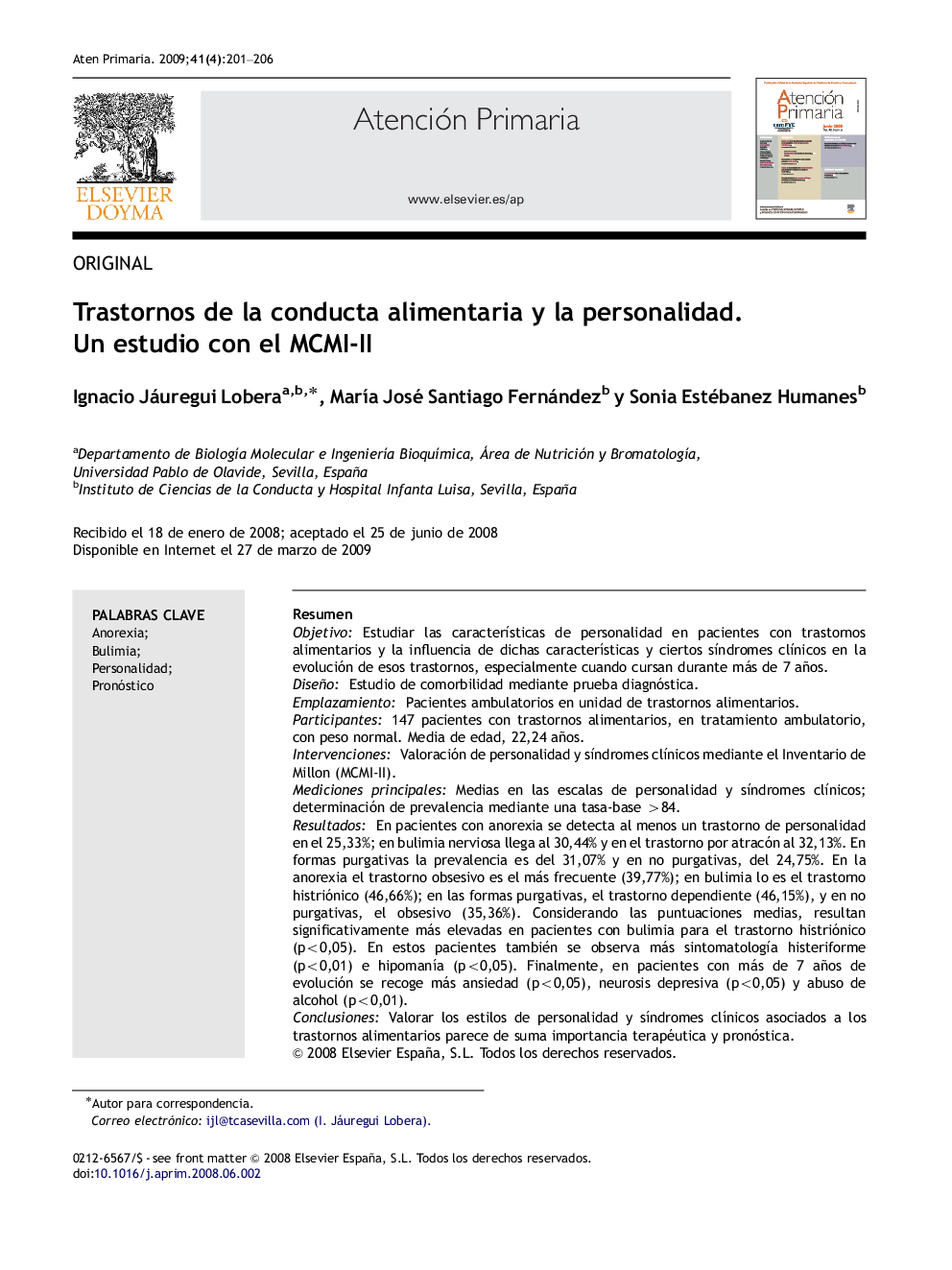| کد مقاله | کد نشریه | سال انتشار | مقاله انگلیسی | نسخه تمام متن |
|---|---|---|---|---|
| 3458143 | 1230954 | 2009 | 6 صفحه PDF | دانلود رایگان |

ResumenObjetivoEstudiar las características de personalidad en pacientes con trastornos alimentarios y la influencia de dichas características y ciertos síndromes clínicos en la evolución de esos trastornos, especialmente cuando cursan durante más de 7 años.DiseñoEstudio de comorbilidad mediante prueba diagnóstica.EmplazamientoPacientes ambulatorios en unidad de trastornos alimentarios.Participantes147 pacientes con trastornos alimentarios, en tratamiento ambulatorio, con peso normal. Media de edad, 22,24 años.IntervencionesValoración de personalidad y síndromes clínicos mediante el Inventario de Millon (MCMI-II).Mediciones principalesMedias en las escalas de personalidad y síndromes clínicos; determinación de prevalencia mediante una tasa-base >84.ResultadosEn pacientes con anorexia se detecta al menos un trastorno de personalidad en el 25,33%; en bulimia nerviosa llega al 30,44% y en el trastorno por atracón al 32,13%. En formas purgativas la prevalencia es del 31,07% y en no purgativas, del 24,75%. En la anorexia el trastorno obsesivo es el más frecuente (39,77%); en bulimia lo es el trastorno histriónico (46,66%); en las formas purgativas, el trastorno dependiente (46,15%), y en no purgativas, el obsesivo (35,36%). Considerando las puntuaciones medias, resultan significativamente más elevadas en pacientes con bulimia para el trastorno histriónico (p<0,05). En estos pacientes también se observa más sintomatología histeriforme (p<0,01) e hipomanía (p<0,05). Finalmente, en pacientes con más de 7 años de evolución se recoge más ansiedad (p<0,05), neurosis depresiva (p<0,05) y abuso de alcohol (p<0,01).ConclusionesValorar los estilos de personalidad y síndromes clínicos asociados a los trastornos alimentarios parece de suma importancia terapéutica y pronóstica.
ObjectiveTo study the personality characteristics in patients with eating behaviour disorders and the influence of these characteristics, and certain clinical syndromes on the progress of these disorders, particularly when they have lasted more than seven years.DesignStudy of comorbidity using a diagnostic test.SettingEating behaviour disorders unit outpatients.ParticipantsA total of 147 patients with eating behaviour disorders being treated as outpatients. They were of normal weight, with a mean age of 22.24 years.InterventionsAssessment of personality and clinical syndromes using the Millon Clinical Multiaxial Inventory (MCMI-II).Main measurementsMeans of the personality and clinical syndromes scales and determination of prevalence using a rate-base >84.ResultsAt least one personality disorder was detected in 25.33% of patients with anorexia, 30.44% with bulimia nervosa and 32.13% with binge-eating disorder. In the purgative and non-purgative forms the prevalence was 31.07% and 24.75%, respectively. An obsessive disorder is more common in anorexia (39.77%); a histrionic disorder in bulimia (46.66%); a dependent disorder in the purgative forms (46.15%), and an obsessive one in the no-purgative forms (35.36%). As regards the mean scores, they were significantly higher in patients with bulimia for the histrionic disorder (P<.05). More hysterical type symptoms and hypomania were also observed in these patients (P<.01 and P<.05, respectively). Finally, the patients who had suffered the disorder for more than seven years registered more anxiety (P<.05), depressive neurosis (P<.05) and alcohol abuse (P<.01).ConclusionsTo assess personality styles and clinical syndromes associated with eating behaviour disorders can be an important therapeutic and prognostic tool.
Journal: Atención Primaria - Volume 41, Issue 4, April 2009, Pages 201–206